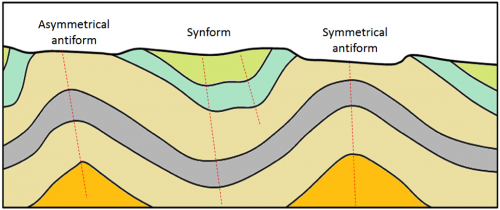Answers to Chapter 13 Review Questions
1. Convergent plate boundaries are the most likely to contribute to compression, divergent boundaries to extension, and transform boundaries to shearing. However, all of these stress regimes can exist at any one of these boundaries.
2. When elastic strain takes place the rock can rebound to its original shape when stress is removed. Plastic strain is permanent.
3. Ductile deformation is more likely under higher temperatures and confining pressures. It is more likely when rocks are deformed slowly, and by compression. It is more likely for sedimentary rocks, and for rocks without fluids.
4. Axial traces are shown with dashed red lines.

5. Volcanic rocks cool quickly at surface and the resulting reduction in volume can easily lead to fracturing.
6. In a normal fault the rock above the fault (hanging wall or headwall) moves down with respect to the lower rock (footwall). This normally indicates extension. In a reverse fault the hanging wall is pushed up, which indicates compression.
7. Most faults near transform boundaries are strike-slip faults, meaning that there is horizontal motion along the fault.
8.(i) The beds are dipping at about 30˚ to the northwest. (ii) “a” is a dyke and it is dipping steeply to the northeast. (iii) “b” is a fault and it is dipping steeply to the southeast. (iv) The motion on fault “b” appears to be right-handed.


